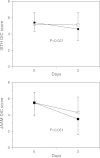A randomized, controlled, multicenter trial of the effects of antithrombin on disseminated intravascular coagulation in patients with sepsis
- PMID: 24342495
- PMCID: PMC4057033
- DOI: 10.1186/cc13163
A randomized, controlled, multicenter trial of the effects of antithrombin on disseminated intravascular coagulation in patients with sepsis
Abstract
Introduction: To test the hypothesis that the administration of antithrombin concentrate improves disseminated intravascular coagulation (DIC), resulting in recovery from DIC and better outcomes in patients with sepsis, we conducted a prospective, randomized controlled multicenter trial at 13 critical care centers in tertiary care hospitals.
Methods: We enrolled 60 DIC patients with sepsis and antithrombin levels of 50 to 80% in this study. The participating patients were randomly assigned to an antithrombin arm receiving antithrombin at a dose of 30 IU/kg per day for three days or a control arm treated with no intervention. The primary efficacy end point was recovery from DIC on day 3. The analysis was conducted with an intention-to-treat approach. DIC was diagnosed according to the Japanese Association for Acute Medicine (JAAM) scoring system. The systemic inflammatory response syndrome (SIRS) score, platelet count and global markers of coagulation and fibrinolysis were measured on day 0 and day 3.
Results: Antithrombin treatment resulted in significantly decreased DIC scores and better recovery rates from DIC compared with those observed in the control group on day 3. The incidence of minor bleeding complications did not increase, and no major bleeding related to antithrombin treatment was observed. The platelet count significantly increased; however, antithrombin did not influence the sequential organ failure assessment (SOFA) score or markers of coagulation and fibrinolysis on day 3.
Conclusions: Moderate doses of antithrombin improve DIC scores, thereby increasing the recovery rate from DIC without any risk of bleeding in DIC patients with sepsis.
Trial registration: UMIN Clinical Trials Registry (UMIN-CTR) UMIN000000882.
Figures




Similar articles
-
Comparison of Protective Effects of Recombinant Antithrombin Gamma and Plasma-Derived Antithrombin on Sepsis-Induced Disseminated Intravascular Coagulation and Multiple Organ Failure.Clin Appl Thromb Hemost. 2020 Jan-Dec;26:1076029620981630. doi: 10.1177/1076029620981630. Clin Appl Thromb Hemost. 2020. PMID: 33332196 Free PMC article.
-
The usefulness of antithrombin activity monitoring during antithrombin supplementation in patients with sepsis-associated disseminated intravascular coagulation.Thromb Res. 2015 May;135(5):897-901. doi: 10.1016/j.thromres.2015.03.007. Epub 2015 Mar 10. Thromb Res. 2015. PMID: 25784136
-
Antithrombin supplementation and risk of bleeding in patients with sepsis-associated disseminated intravascular coagulation.Thromb Res. 2016 Sep;145:46-50. doi: 10.1016/j.thromres.2016.07.016. Epub 2016 Jul 27. Thromb Res. 2016. PMID: 27479532
-
Present and future of anticoagulant therapy using antithrombin and thrombomodulin for sepsis-associated disseminated intravascular coagulation: a perspective from Japan.Int J Hematol. 2016 Mar;103(3):253-61. doi: 10.1007/s12185-015-1904-z. Epub 2015 Nov 20. Int J Hematol. 2016. PMID: 26588929 Review.
-
Pathogenesis and treatment of disseminated intravascular coagulation in the septic patient.J Crit Care. 2001 Dec;16(4):167-77. doi: 10.1053/jcrc.2001.30666. J Crit Care. 2001. PMID: 11815902 Review.
Cited by
-
Peritoneal lavage with hydrogen-rich saline can be an effective and practical procedure for acute peritonitis.Surg Today. 2021 Nov;51(11):1860-1871. doi: 10.1007/s00595-021-02271-z. Epub 2021 Mar 31. Surg Today. 2021. PMID: 33787966
-
Neutrophil, neutrophil extracellular traps and endothelial cell dysfunction in sepsis.Clin Transl Med. 2023 Jan;13(1):e1170. doi: 10.1002/ctm2.1170. Clin Transl Med. 2023. PMID: 36629024 Free PMC article. Review.
-
Antithrombin Therapy: Current State and Future Outlook.Clin Appl Thromb Hemost. 2023 Jan-Dec;29:10760296231205279. doi: 10.1177/10760296231205279. Clin Appl Thromb Hemost. 2023. PMID: 37822179 Free PMC article.
-
Signaling pathways and intervention therapies in sepsis.Signal Transduct Target Ther. 2021 Nov 25;6(1):407. doi: 10.1038/s41392-021-00816-9. Signal Transduct Target Ther. 2021. PMID: 34824200 Free PMC article. Review.
-
Usefulness of Measuring Changes in SOFA Score for the Prediction of 28-Day Mortality in Patients With Sepsis-Associated Disseminated Intravascular Coagulation.Clin Appl Thromb Hemost. 2019 Jan-Dec;25:1076029618824044. doi: 10.1177/1076029618824044. Clin Appl Thromb Hemost. 2019. PMID: 30808223 Free PMC article.
References
-
- Fourrier F, Chopin C, Huart JJ, Runge I, Caron C, Goudemand J. Double-blind, placebo-controlled trial of antithrombin III concentrates in septic shock with disseminated intra vascular coagulation. Chest. 1993;17:882–888. - PubMed
-
- Eisele B, Lamy M, Thijs LG, Keinecke HO, Schuster HP, Matthias FR, Fourrier F, Heinrichs H, Delvos U. Antithrombin III in patients with severe sepsis. A randomized, placebo-controlled, double-blind multicenter trial plus a meta-analysis on all randomized, placebo-controlled, double-blind trials with antithrombin III in severe sepsis. Intensive Care Med. 1998;17:663–672. doi: 10.1007/s001340050642. - DOI - PubMed
Publication types
MeSH terms
Substances
LinkOut - more resources
Full Text Sources
Other Literature Sources
Medical

